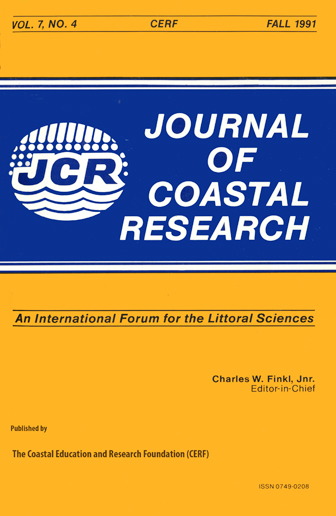Sediments and Sedimentary Structures of a Barred, Nontidal Coastline, Southern Shore of Lake Michigan
Keywords:
Coastal sedimentary structures, depositional sequences, shoreface bedforms, storm-wave responseAbstract
A microenergy, nontidal sandy beach along the southern shore of Lake Michigan was studied in detail over a 2-day period that followed a week of storm activity. Box cores, grab samples, trenches, and topographic/bathymetric surveys were used to determine the impact of storm processes on sediment characteristics in the area. The coastal reach consisted of a backshore and foreshore separated by a low berm, a plungepoint at the base of the swash zone, and a bartrough- rip channel system in the upper shoreface. Bedforms in the shoreface consisted mainly of 2-D and 3-D ripples with crests oriented subparallel to shore and perpendicular to the incoming waves. Ladderback interference ripples and double-crested ripples occurred on the inshore bar in response to the interaction of incoming waves with shoreface topography. Their occurrence, along with the occurrence of flat-topped ripples and herringbone crossbeds elsewhere in Lake Michigan, reduces the usefulness of these structures in paleoenvironmental reconstructions. Box cores revealed that granular sands occurred in subparallel lakeward-dipping plane beds landward of the plungepoint and that sediments at the plungepoint consisted of massive to poorly stratified pebbly sands. Moderately coarse-grained sands occurred in longshore-oriented small-scale trough sets, in the interbar troughs, and in lakeward-dipping trough sets in the rip channel. Bars consisted of medium- to fine-grained sands in larger-scale, landward-oriented small-scale crossbeds, and swaley crossbeds on the landward slope and the bar crest, and also contained lakeward dipping, subhorizontal plane beds and swaley crossbeds on the lakeward slope. Internal sedimentary structures bore no relationship to the bedforms that covered the shoreface during the study period and were probably the product of storm-driven processes that operated during the previous week. Although longshore bars in Lake Michigan typically migrate onshore during post-storm periods, the facies sequences observed in box cores indicate that they are not counterparts of ridges on tidally influenced foreshores.


